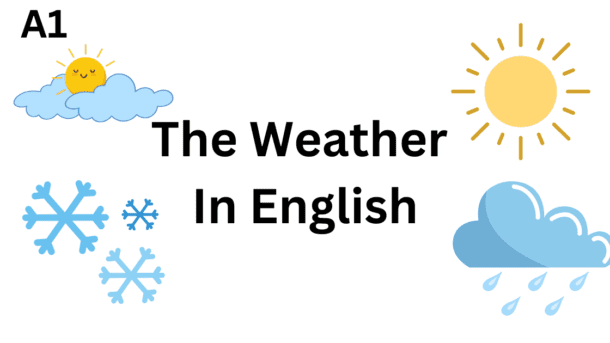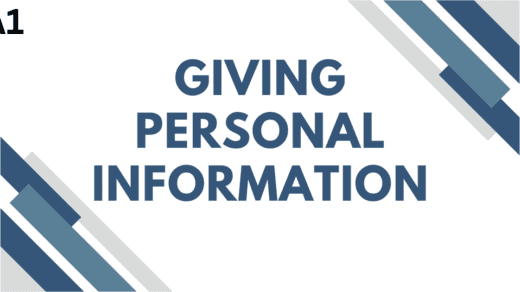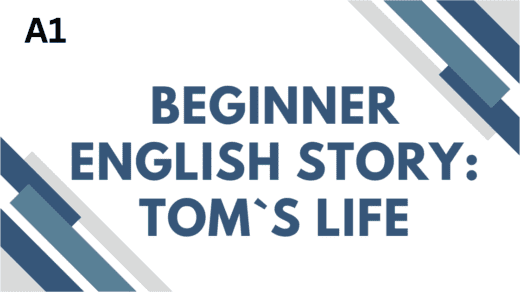The Weather In English: Weather refers to the atmospheric conditions in a specific place at a particular time, including factors such as temperature, humidity, precipitation, wind, and visibility. Common terms used to describe weather include “sunny,” “cloudy,” “rainy,” “stormy,” “snowy,” and “foggy.” The temperature is often measured in degrees Celsius or Fahrenheit. Understanding The Weather In English patterns can help in planning daily activities, dressing appropriately, and preparing for extreme weather events.
Discussing the Weather In English
Present vocabulary related to different weather in English conditions:
Weather In English Vocabulary
- Sunny: warm and bright, without clouds
Example: “It’s a sunny day today.” - Cloudy: sky covered with clouds
Example: “I don’t like walking outside on a cloudy day.” - Rainy: raining or wet
Example: “Bring a raincoat if it’s going to rain tomorrow.” - Windy: having a strong wind
Example: “Be careful when walking outside on a windy day.” - Snowy: covered in snow
Example: “It’s perfect weather for skiing when it’s snowy.” - Stormy: strong winds, heavy rain, or thunderstorms
Example: “Avoid traveling during severe stormy weather.” - Thunderstorm: a stormy weather with lightning and thunder
Example: “There is a thunderstorm forecasted for tonight.” - Misty: a fine fog or haze
Example: “The misty weather is perfect for a romantic walk.” - Foggy: thick fog or haze
Example: “Be careful driving in foggy conditions.” - Hot: warm weather above average temperature
Example: “The hot summer weather makes it difficult to sleep.” - Cold: low-temperature weather
Example: “I’m going to wear warm clothing in the cold winter weather.”
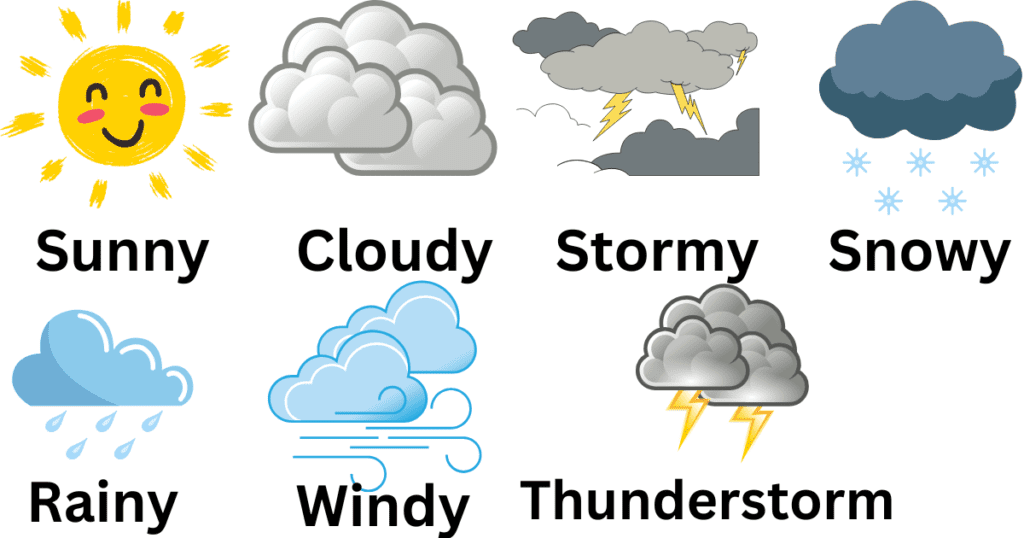
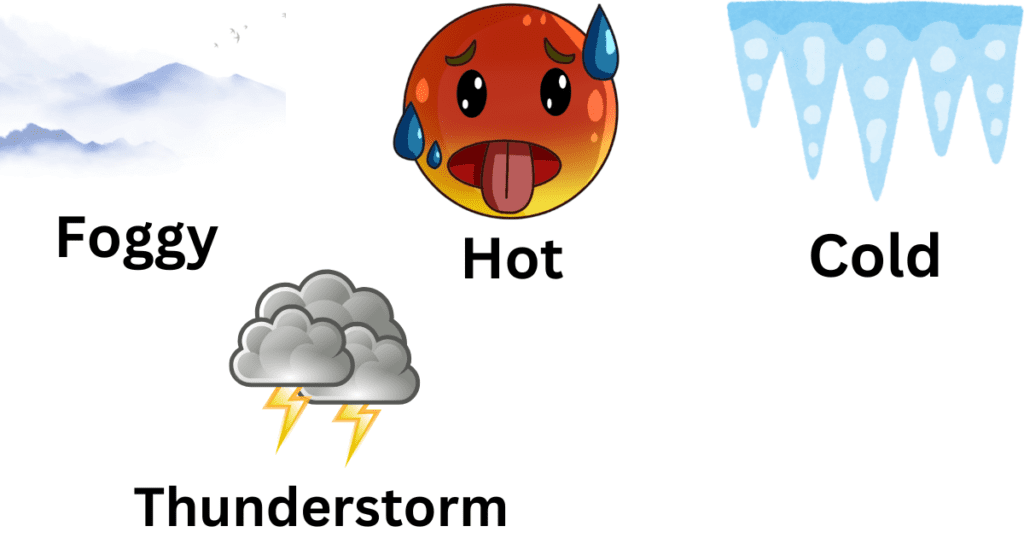
Phrases and Expressions:
“It’s perfect weather for…”: used to describe suitable weather for an activity
Example: “It’s perfect weather for swimming.”
“The weather is…”: used to describe the weather
Example: “The weather is sunny today.”
“There is a chance of…”: used to predict the weather
Example: “There is a chance of rain tomorrow.”
“It’s going to be…”: used to forecast the weather
Example: “It’s going to be hot this week.”
“The weatherman says…”: used to talk about the weather forecast
Example: “The weatherman says it’s going to be stormy tonight.”
Basic Sentence Structure
Introduce the structure for discussing the weather:
- Present simple: “It is [adjective] today.”
- Future simple: “It will be [adjective] tomorrow.”
Provide examples:
- “Today, it is rainy and cold.”
- “Tomorrow, it will be sunny and warm.”
Common Questions About Weather In English
- “What’s the weather like today?”
- “How do you feel about this type of weather?”
- “What will the weather be like tomorrow?”
- “Do you prefer sunny or rainy days?”
The Weather In English Sample Dialogue
Here’s a sample dialogue to showcase how students can effectively use vocabulary and ask questions throughout the The Weather In English lesson:
Student A: “What’s the weather like today?”
Student B: “It’s quite humid and hot today. I feel like it’s a perfect day for the beach. How about you?”
Student A: “I prefer cooler weather. What do you think it will be like tomorrow?”
Student B: “Tomorrow, it will be sunny but with a chance of rain later in the evening. I heard it might storm in the afternoon.”
Student A: “Do you think the storm will affect our plans for the weekend?”
Student B: “If it storms, we might need to find an indoor activity. I dislike going out in storms. What’s your favorite type of activity when it’s rainy?”
Student A: “I love to stay in and read a good book! What about you?”
Pro Tips For Studying The Weather In English:
- Build Your Vocabulary: Start by creating a list of weather-related vocabulary. Include terms for different weather conditions (e.g., sunny, rainy, cloudy), phenomena (e.g., tornado, hurricane), and temperature descriptors (e.g., hot, cold, mild). Flashcards can be useful for memorization.
- Engage with Media: Watch weather reports on news channels or platforms like YouTube. Pay attention to how the weather is described and practice repeating phrases. Listening to weather-themed podcasts can also reinforce vocabulary through context.
- Use Visual Aids: Create a weather chart that includes images and descriptions of various weather conditions. This can be a reference tool and help with visual memory. You can also use apps that display weather forecasts in real-time.
- Role-play: Practice speaking by role-playing as a meteorologist giving a weather report. This will help reinforce vocabulary and boost your speaking confidence. You could do this in front of a mirror or with a friend.
- Keep a Weather Journal: For practical application, maintain a weather journal where you record daily weather conditions, describe the weather in English, and note any new vocabulary you come across. This will help you practice writing and observation skills.
- Interactive Learning: Use language-learning apps or websites that offer quizzes and games focused on weather vocabulary and phrases. These interactive tools can make learning fun and more engaging.
- Review Regularly: Schedule regular review sessions to revisit vocabulary and concepts. This can be done through flashcards, quizzes, or simply discussing the weather with others in English.
- Practice Conversation: Find language exchange partners or join conversation groups where you can discuss the weather in English. Use real-time weather events for discussion topics to keep it relevant.
Conclusion
This speaking lesson plan effectively covers the topic of The Weather In English by providing students with essential vocabulary, question formats, and opportunities for practical application. By participating you will gain confidence and fluency in discussing the weather conditions in English.
